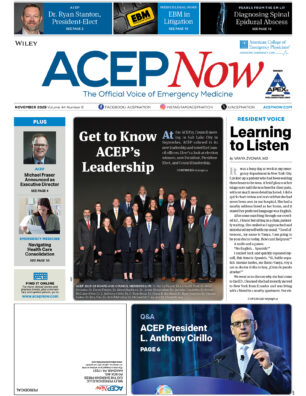In the November issue of the Annals of Emergency Medicine, the American College of Emergency Physicians published a clinical policy focusing on critical issues in the emergency department management of adult patients presenting with community-acquired pneumonia (CAP). This is the first revision of a policy on CAP that was initially published in 2001.
Explore This Issue
ACEP News: Vol 28 – No 11 – November 2009This clinical policy can also be found on ACEP’s Web site, www.acep.org, and will be abstracted on the National Guideline Clearinghouse Web site, www.guidelines.gov.
This clinical policy takes an evidence-based approach to answering two frequently encountered questions.
This clinical policy takes an evidence-based approach to answering two frequently encountered questions related to emergency department decision making. Recommendations (Level A, B, or C) for patient management are provided based on the strength of evidence using the Clinical Policies Committee’s well-established methodology:
- Level A recommendations represent patient management principles that reflect a high degree of clinical certainty.
- Level B recommendations represent patient management principles that reflect moderate clinical certainty.
- Level C recommendations represent other patient management strategies based on preliminary, inconclusive, or conflicting evidence, or based on consensus of the members of the Clinical Policies Committee.
During development, this clinical policy was reviewed by individual emergency physicians and by individual members of the American College of Chest Physicians, the American College of Physicians, the Infectious Diseases Society of America, the Institute for Clinical Systems Improvement, the Society for Academic Emergency Medicine, and ACEP’s Section on Critical Care Medicine. Their responses were used to refine and enhance this policy; however, their responses do not imply endorsement of this clinical policy.
CAP is a major health problem in the United States, with a price tag of nearly $9 billion and an age-adjusted mortality rate of up to 22%. CAP has been recently redefined as an acute pulmonary infection in a patient who has been neither hospitalized nor living in a long-term care facility 14 or more days before presentation. Mortality rates have not improved significantly during the decades for which data are available.
Current quality and performance measures outlining strict time-to-antibiotic goals are not only difficult to achieve in overcrowded emergency departments, but also can lead to treatment without diagnostic confirmation.
The new ACEP clinical policy on CAP addresses these issues and how emergency practitioners can best manage CAP, as most patients with CAP initially present to the emergency department.
Question 1: Are routine blood cultures indicated in patients admitted with CAP?
Core measures include two expectations in regard to blood cultures. First, if blood cultures are drawn in the emergency department, they should be drawn prior to administration of antibiotics. Second, blood cultures should be drawn within a 24-hour window before or after transfer or admission to the ICU, if transfer occurs during the first 24 hours of admission. There are few available data to support using blood cultures to manage CAP. Studies reviewed revealed that they are infrequently positive (1%-16%) and infrequently lead to change in management (0%-5%), especially in low-risk patients.
- Level A recommendation. None specified.
- Level B recommendation. Do not routinely obtain blood cultures in patients admitted with CAP.
- Level C recommendation. Consider obtaining blood cultures in higher-risk patients admitted with CAP (e.g., severe disease, immunocompromise, significant comorbidities, or other risk factors for infection with resistant organisms).
Question 2: In adult patients with CAP without severe sepsis, is there a benefit in mortality or morbidity from the administration of antibiotics within a specific time course?
Quality and performance measures outline door-to-antibiotic cutoffs theoretically designed to improve morbidity and mortality outcomes for CAP. The actual benefits of these strict timelines have been questioned by recent studies.
- Level A recommendation. None specified.
- Level B recommendation. There is insufficient evidence to establish a benefit in mortality or morbidity from antibiotics administered less than 4, 6, or 8 hours from emergency department arrival.
- Level C recommendation. Administer antibiotics as soon as feasible once the diagnosis of CAP is established; there is insufficient evidence to establish a benefit in morbidity or mortality from antibiotics administered within any specific time course.
There is insufficient evidence to dictate a specific time interval for antibiotic administration in patients diagnosed with CAP in the emergency department. In the non-critically ill patient, emergency physicians would be prudent to administer antibiotics as early as possible after a definitive diagnosis is made. Future prospective studies may determine a specific time interval within which antibiotics should be given to improve morbidity or mortality. n
Dr. Jacobson is the chief resident of emergency medicine at Mt. Sinai School of Medicine, New York, N.Y. Dr. Nazarian is assistant clinical professor of emergency medicine at Mt. Sinai School of Medicine/Elmhurst Hospital Center, New York, N.Y., and is a member of ACEP’s Clinical Policies Committee.
Pages: 1 2 3 | Multi-Page


No Responses to “ACEP Clinical Policy: Critical Issues in the Management Of Adult Patients With Community-Acquired Pneumonia”